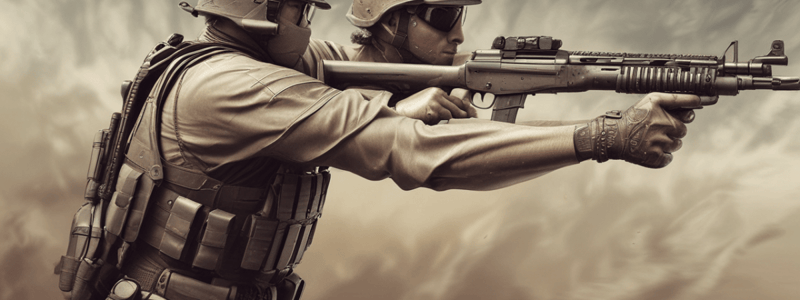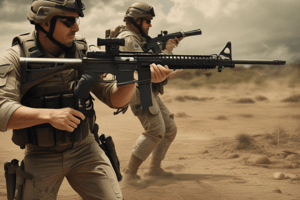Podcast
Questions and Answers
What percentage of officers killed were attacked with guns?
What percentage of officers killed were attacked with guns?
- 80%
- 100%
- 95% (correct)
- 50%
What percentage of officers were able to shoot back during an encounter?
What percentage of officers were able to shoot back during an encounter?
- 27% (correct)
- 60%
- 15%
- 40%
What is the average distance between an officer and their assailant during a fatal encounter?
What is the average distance between an officer and their assailant during a fatal encounter?
- 5 yards
- 10 yards
- 20 yards
- 7 yards (correct)
What percentage of shootings involve more than one assailant?
What percentage of shootings involve more than one assailant?
What type of tactical plan is recommended when approaching a situation where someone has physical possession of a deadly weapon?
What type of tactical plan is recommended when approaching a situation where someone has physical possession of a deadly weapon?
What is the term for the phenomenon where an officer observes the danger but does not recognize it?
What is the term for the phenomenon where an officer observes the danger but does not recognize it?
What is the primary goal of center mass shooting?
What is the primary goal of center mass shooting?
What is the effect of stress on an officer's ability to perform fundamental firearms techniques?
What is the effect of stress on an officer's ability to perform fundamental firearms techniques?
What is the recommended approach to enhancing officer survival?
What is the recommended approach to enhancing officer survival?
What is the purpose of recovery rate in survival loading techniques?
What is the purpose of recovery rate in survival loading techniques?
What is the primary goal of the stress combat courses?
What is the primary goal of the stress combat courses?
What is the average rate of officer deaths in the U.S.?
What is the average rate of officer deaths in the U.S.?
What is the purpose of encounter training?
What is the purpose of encounter training?
What is the significance of using cover and concealment in the stress combat courses?
What is the significance of using cover and concealment in the stress combat courses?
What is the relationship between the stress combat courses and the basic fundamentals of marksmanship?
What is the relationship between the stress combat courses and the basic fundamentals of marksmanship?
What is one of the skills that trainees will be required to demonstrate in the stress combat courses?
What is one of the skills that trainees will be required to demonstrate in the stress combat courses?
What is the importance of proper decision-making in the stress combat courses?
What is the importance of proper decision-making in the stress combat courses?
What is the instruction related to empty brass after firing a weapon?
What is the instruction related to empty brass after firing a weapon?
What is the first action the shooter takes after finishing exercises in the shotgun course?
What is the first action the shooter takes after finishing exercises in the shotgun course?
How many targets does the shooter engage in shooting box one in the handgun course?
How many targets does the shooter engage in shooting box one in the handgun course?
What is the purpose of the exercises before the shooter begins the course?
What is the purpose of the exercises before the shooter begins the course?
What is the primary concern when using #4 Buck Shot in a given encounter?
What is the primary concern when using #4 Buck Shot in a given encounter?
What does the shooter do after engaging all hostile targets in shooting box three in the handgun course?
What does the shooter do after engaging all hostile targets in shooting box three in the handgun course?
In armed multiple adversary encounters, what is the priority when firing?
In armed multiple adversary encounters, what is the priority when firing?
What is the minimum number of rounds the shooter is issued in the handgun course?
What is the minimum number of rounds the shooter is issued in the handgun course?
What does the shooter do when they reach shooting box three in the shotgun course?
What does the shooter do when they reach shooting box three in the shotgun course?
What is the primary cause of 'accidental' discharges and 'malfunctions' in firearms?
What is the primary cause of 'accidental' discharges and 'malfunctions' in firearms?
What is the primary reason for unintentional hits in armed encounters?
What is the primary reason for unintentional hits in armed encounters?
What is the purpose of the instructor following the shooter from station to station in the handgun course?
What is the purpose of the instructor following the shooter from station to station in the handgun course?
What does the shooter do after finishing the course in the shotgun course?
What does the shooter do after finishing the course in the shotgun course?
What is the purpose of using 'verbal challenge procedures' in armed encounters?
What is the purpose of using 'verbal challenge procedures' in armed encounters?
What is the primary concern when shooting from a moving vehicle?
What is the primary concern when shooting from a moving vehicle?
What is the arrangement of shoot and no-shoot targets changed for each shooter in the course?
What is the arrangement of shoot and no-shoot targets changed for each shooter in the course?
What is the purpose of the shooter doing ten pushups or jumping jacks in the APPLICATION - SHOTGUN exercise?
What is the purpose of the shooter doing ten pushups or jumping jacks in the APPLICATION - SHOTGUN exercise?
How many pushups does the shooter do in the handgun course?
How many pushups does the shooter do in the handgun course?
What is the primary reason for using cover and concealment in armed encounters?
What is the primary reason for using cover and concealment in armed encounters?
What is the purpose of announcing oneself as an officer and issuing a clear, concise command in armed encounters?
What is the purpose of announcing oneself as an officer and issuing a clear, concise command in armed encounters?
What is the primary concern when using Rifled Slug rounds in armed encounters?
What is the primary concern when using Rifled Slug rounds in armed encounters?
Study Notes
Stress Combat Courses
- The courses are designed to familiarize trainees with factors that affect or influence firearms performance under high-stress conditions.
- The courses aim to build awareness, skills, confidence, and proper habits among trainees to avoid firearms accidents.
Objectives
- Identify and explain officer survival, stress-related concepts.
- Demonstrate knowledge of concepts and proficiency in shooting stress combat courses.
- Explain the relationship between realistic firearms encounter training and officer reactions.
Patterns of Encounter
- 85% of all officers killed are less than seven yards from their assailant.
- 2 of 3 fatal officer shootings occur during the hours of darkness or where light is very dim.
- Confrontations are usually over in 2 to 3 seconds.
- A total of 3 shots are exchanged between officer and assailant.
- The assault is 2 1/2 times more likely to occur outdoors.
- 4 of 10 shootings involve more than one assailant.
- In 7 out of 10 shootings, a handgun of the same caliber or smaller than the one the officer carries is used.
Survival Tactics and Techniques
- Handgun readiness: when approaching a situation where someone has a deadly weapon, or during high-risk activities.
- Shotgun readiness: when dealing with a felony in progress, hazardous vehicle stops, wanted felons, or high-risk situations.
- Cover and concealment: understanding the difference between obstacles that can stop bullets (cover) and hiding from view (concealment).
- The "ostrich effect": observing danger but not recognizing it, leading to poor preparation and reaction.
- Survival loading techniques: conditioning oneself to reload quickly and efficiently in high-stress situations.
- The officer survival triangle: tactics, shooting skills, and mental/physical conditioning.
- The "fatal funnel effect": being aware of doorway approaches and the potential for fatal encounters.
Shooting Tactics and Techniques
- Center mass shooting: aiming for the center of the body to cause maximum interference with the assailant's life support structure.
- The effects of stress on firearms performance: adrenaline surge, increased oxygen use, diminished ability to distinguish time, colors, and distance, and thought distraction.
- Tactical use of the 12-gauge shotgun: knowing when to use different types of ammunition (e.g., .00 Buck, rifled slug, #4 Buck Shot).
- Armed multiple adversary encounters: prioritizing targets based on proximity and danger.
- Shooting tactics and techniques in close/distance, rapid-time frame encounters: using movement to immobilize or befuddle the suspect, and getting out of the line of fire quickly.
Accidental Discharges and Malfunctions
- Accidental discharges and malfunctions are often caused by human error or neglect, not mechanical failure.
- Lack of control, poor handling techniques, or poor maintenance can lead to accidents.
Unintentional Hits
- Unintentional hits usually involve negligent judgment, such as shooting without considering the bullet's trajectory.
- Warning shots, shooting at moving vehicles, and firing from a moving vehicle can lead to unintentional hits.
Verbal Challenge Procedures
- Announcing oneself as an officer and issuing a clear, concise command can buy time and establish the suspect's identity and intentions.
- Issuing a verbal challenge from behind cover can increase safety.
Application - Shotgun and Handgun
- Shotgun and handgun courses involve simulated high-stress situations, requiring shooters to move through multiple shooting stations, using cover and concealment, and reloading as necessary.
- Shooters are required to identify and engage multiple targets, using different types of ammunition and techniques.
Studying That Suits You
Use AI to generate personalized quizzes and flashcards to suit your learning preferences.
Description
This course prepares trainees for high-stress conditions, focusing on firearms performance and building awareness, skills, confidence, and good habits.




